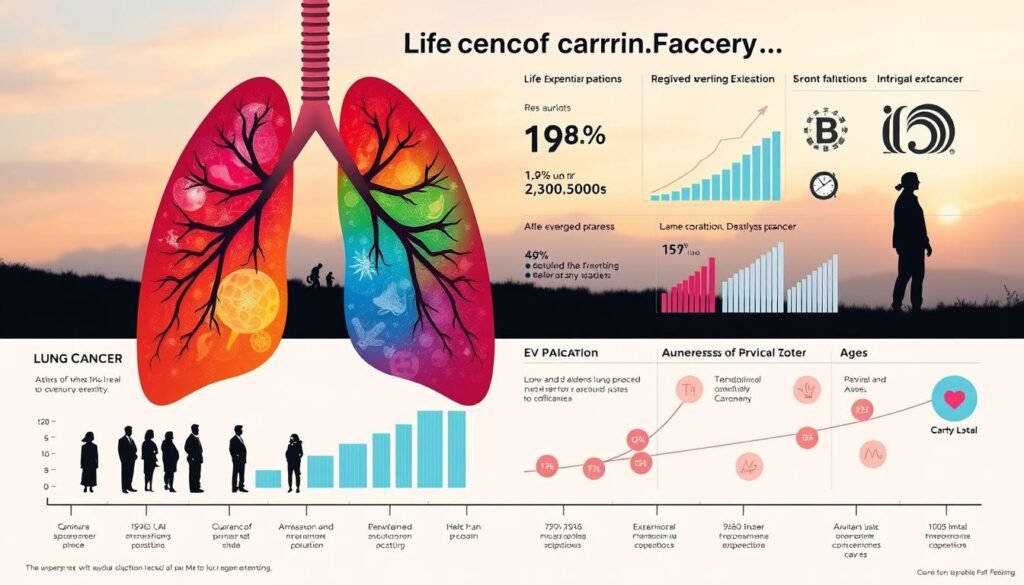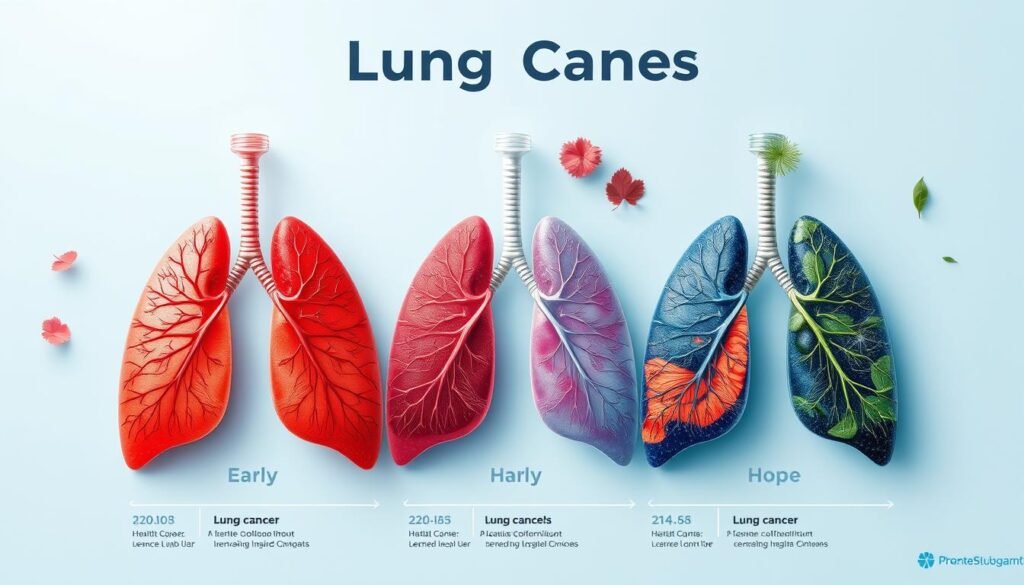Did you know that approximately 53% of all lung cancers have spread by the time they are found? This fact highlights how vital early detection is for improving survival chances. Many people worry about how long does it take for lung cancer to kill you, especially since more than 80% of patients die within five years of finding out they have it. Additionally, over half of those diagnosed do not live more than one year.
The life expectancy for lung cancer patients can vary greatly. It depends on the stage of the disease, the cancer type, and the patient’s overall health. Most cases are Non-small cell lung cancer (NSCLC), making up about 80% to 85% of all cases. NSCLC’s survival rates are much different from Small cell lung cancer (SCLC), which is less common. Survival often depends on several critical factors that influence how well treatments work. This shows why early screening is so important.
Knowing about lung cancer survival rates is key for patients and their families. It helps them make choices about treatment and care. Early detection, in particular, can significantly improve outcomes for those with localized lung cancer. For specific survival statistics, click here.
Key Takeaways
- About 1 out of 4 people with lung cancer survive for 5 years or longer post-diagnosis.
- The survival rate for localized NSCLC is around 63.7% for 5 years.
- Approximately 6% of stage 4 lung cancer patients are likely to live for 5 years.
- Providing screening could reduce lung cancer mortality rates by about 20%.
- The average survival time without treatment is over 7 months for NSCLC.
- More than half of lung cancer patients may not survive their first year.
- Early detection is critical for improving survival rates.
Understanding Lung Cancer Survival Rates
Lung cancer survival rates show how various factors change patient outcomes. They help patients, families, and doctors make smart choices about treatment. These rates are key to understanding the battle ahead.
General Statistics on Lung Cancer Survival
General stats reveal that less than 20% of lung cancer patients live beyond five years after diagnosis. This makes lung cancer one of the deadliest diseases, almost as severe as liver cancer. It is second only to pancreatic cancer in terms of its deadly nature.
In specific types like non-small-cell lung cancer (NSCLC), the situation is a bit different. If the cancer is still localized, the five-year survival rate can be as high as 60%. But, if it has spread far, the survival rate plummets to 6%.
Factors Affecting Survival Rates
The survival of lung cancer patients is swayed by multiple factors. These are crucial.
- Cancer Stage: Catching the cancer early means better chances of survival. For example, those with Stage IA1 NSCLC have a 90% chance of surviving five years.
- Type of Lung Cancer: The survival rate is generally higher for NSCLC than for small-cell lung cancer (SCLC).
- Patient Age: Younger patients usually fare better than older ones.
- Overall Health: Good health can make a big difference in handling treatment and recovery.
- Genetic Mutations: Certain genetic changes can impact how well treatments work. Tests like FISH can detect these.
These details show why lung cancer survival rates are complex. They stress the need for treatments that fit each individual’s circumstances.
Lung Cancer Life Expectancy Overview
The life expectancy for lung cancer varies a lot. It depends on many factors, mainly the disease’s stage when diagnosed. Learning about life expectancy by stages of lung cancer is crucial for patients and their families. Early diagnosis greatly improves survival chances, showing the importance of early detection.
Life Expectancy by Stages of Lung Cancer
Survival rates for lung cancer patients differ by stage. Here are the survival rates:
| Stage | Approximate 5-Year Survival Rate |
|---|---|
| Stage 1 | 65% |
| Stage 2 | 40% |
| Stage 3 | 15% |
| Stage 4 | 5% |
This data shows how vital early detection is for increasing life expectancy in lung cancer. Early-stage cancers offer more treatment options. These can lead to longer survival and a better quality of life.
Importance of Early Detection
Early detection is incredibly important. If lung cancer is found early, treatment can be more successful. This increases the chances of a longer life. Regular screenings and being aware of symptoms can lead to early consultation with doctors. You can learn more about survival statistics and managing lung cancer effectively here.

How Long Does It Take for Lung Cancer to Kill You
Knowing how quickly lung cancer progresses is key for patients and families. The average timeline from diagnosis to death depends on many things. This includes what type and stage the cancer is when found. For example, people with non-small cell lung cancer usually live 5 to 12 months after being diagnosed without treatment. And those with small cell lung cancer may live 3 to 15 months without any treatment.
Average Timeline from Diagnosis to Death
Here’s what the data shows: without treatment, how long people with non-small cell lung cancer can live depends on the cancer’s stage. Here are the median survival rates:
| Stage | Median Survival (Months) |
|---|---|
| Stage I | 13.7 |
| Stage II | 8.4 |
| Stage IIIA | 6.1 |
| Stage IV | 2.0 |
About 80% of lung cancer cases are found at late stages. This greatly reduces the average timeline from diagnosis to death. Tumor growth rate matters too. On average, a tumor of non-small cell lung cancer doubles in size in seven months. This shows why getting treatment fast is so important.
Impact of Treatment on Lifespan
Treatment options like chemotherapy, radiation, and surgery can make a big difference. They can greatly extend how long patients live when used early. But, their success varies a lot from person to person. Things like age, overall health, and cancer specifics affect this.
It’s crucial to get advice from healthcare experts. Knowing the signs and acting fast can lead to earlier help. For info on early signs, see this resource.

Lung Cancer Stages and Their Impact on Prognosis
Lung cancer stages are key in figuring out a patient’s outlook and treatment paths. Knowing these stages helps people understand survival chances. This lets them make smarter health choices. Every stage shows how far the cancer has spread, affecting the chance of getting better.
Stage 1: Early Detection and Survival Rates
Stage 1 lung cancer is only in the lungs and hasn’t spread. This stage has the highest survival chances. About 65 out of 100 people live five years or more after they find out they have it. Finding it early increases the chance of beating it. This shows why regular checks are vital for those at risk.
Stage 2 to Stage 4: Survival Outlook
From Stage 2 to Stage 4, survival rates drop sharply. In Stage 2, around 40 out of 100 people make it five years. This shows a big drop in survival chances. Stage 3 has about a 15% survival rate. Stage 4 is tougher, with only 5% living five years after diagnosis. These numbers show how crucial early finding and action are.

| Lung Cancer Stage | 5-Year Survival Rate |
|---|---|
| Stage 1 | 65% |
| Stage 2 | 40% |
| Stage 3 | 15% |
| Stage 4 | 5% |
Lung Cancer Symptoms You Should Know
Knowing the symptoms of lung cancer is key to catching it early. Early detection improves survival chances. Symptoms vary, from a persistent cough to sudden weight loss. It is vital for everyone to be aware of these signs.
Recognizing Early Signs of Lung Cancer
Early signs of lung cancer might not be obvious. Here’s a list of symptoms you should not ignore:
- Persistent cough that lasts more than a few weeks
- Unexplained chest pain or discomfort
- Constant fatigue that rest doesn’t fix
- Unexpected weight loss or poor appetite
- Difficulty breathing during common activities
Spotting these lung cancer symptoms early can lead to quicker medical help. This might mean more effective treatment. For more on lung cancer, check out this resource.
Advanced Symptoms in Late Stages
Later stages of lung cancer show more serious signs. Here are symptoms of advanced lung cancer:
- Bad shortness of breath due to fluid around the lungs
- Coughing up blood
- Extreme tiredness and muscle loss
- Dramatic weight loss affecting health
- Brain problems if cancer spreads
Families and caregivers must understand these late-stage symptoms. Even if cure isn’t possible, comfort measures can help. Support from doctors can still enhance life quality. Spotting these symptoms and talking to doctors is crucial for care.
Lung Cancer Treatment Options and Their Efficacies
When diagnosed with lung cancer, knowing the treatment choices is crucial. These treatments aim to control the disease and raise life quality. The main options are chemotherapy, radiation, and surgery. The choice depends on the cancer stage and the patient’s health.
Medical Treatments: Chemotherapy and Radiation
Chemotherapy is a key element in treating lung cancer. It targets cells that rapidly divide. Often, it’s combined with other methods, based on the tumor type. Studies show chemotherapy improves results, especially in later stages. Radiation therapy is crucial for those who can’t undergo surgery. It helps shrink tumors and ease pain, vital for comfort care.
Surgical Options for Lung Cancer Patients
Surgery is an option for localized lung cancer. Methods like lobectomy remove the diseased lung parts. This significantly raises survival chances for early-stage patients. About 80.3% of patients undergoing certain surgeries live five years post-operation. Using therapies before and after surgery also helps, showing 60% survival when done right. The surgery approach changes with the tumor type and growth.
| Treatment Type | Five-Year Survival Rate |
|---|---|
| Lung-sparing Surgery | 80.3% |
| Lobectomy | 78.9% |
| Adjuvant Therapy + Surgery | 60% |
| Surgery Alone | 30% |
Understanding lung cancer treatments helps families choose the best path. It leads to better care and longer life.
Lung Cancer Prognosis and Its Variability
Lung cancer prognosis can differ a lot from person to person. This is because many factors change the outlook. Knowing these factors is vital for caring for patients and making treatment choices.
Factors Influencing Individual Prognosis
Several crucial factors affect lung cancer prognosis:
- Diagnosing lung cancer early leads to better chances of survival.
- A patient’s age and health influence how well they can handle the disease and treatment.
- Other health issues, like heart disease or COPD, can make treating lung cancer harder and worse.
- Tumor genes can help doctors understand how well treatments might work.
- Lung cancer patients can also suffer from infections such as pneumonia. This can stress their already weak immune systems more.
Understanding Survival Statistics
Knowing survival stats helps understand lung cancer prognosis. Here are some key figures:
| Statistic | Percentage |
|---|---|
| 5-year survival rate for lung cancer | 15.6% |
| Patients dying within 5 years of diagnosis | Over 80% |
| Patients passing away within the first year | More than 50% |
| Survival rate for localized disease | 52% |
| Survival rate for metastatic cases | 3.6% |
It’s important to know these stats. But, healthcare providers do personal assessments. They use this to set realistic goals and plan treatments.
Lung Cancer Diagnosis: What to Expect
Getting told you have lung cancer can feel crushing. It’s key to know what tests you’ll undergo. Doctors start with scans like CTs and MRIs to look into your lungs closely. Then, biopsies help check for cancer cells. Tests about lung health give more info. These steps help doctors figure out how to treat the cancer best.
Tests and Procedures for Diagnosing Lung Cancer
The path to diagnosing lung cancer involves different tests. For people at higher risk, low-dose CT scans are used first. Biopsies are also key to confirm cancer is there. The goal is to understand the cancer’s stage and spread. This info helps in making a personalized treatment plan.
Interpreting Diagnostic Results
Interpreting diagnostic results is crucial for patients and doctors. Knowing what the results mean guides the choice of treatment. This can range from surgery to drugs targeting cancer. Open talks between doctors and patients ensure everyone knows the plan. It’s important for facing the disease together.